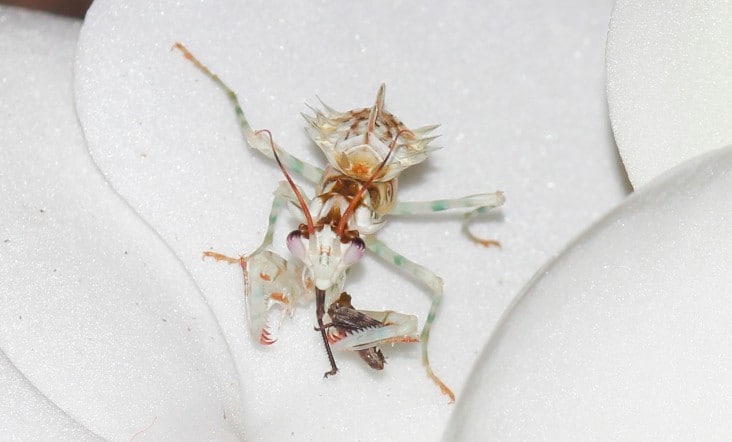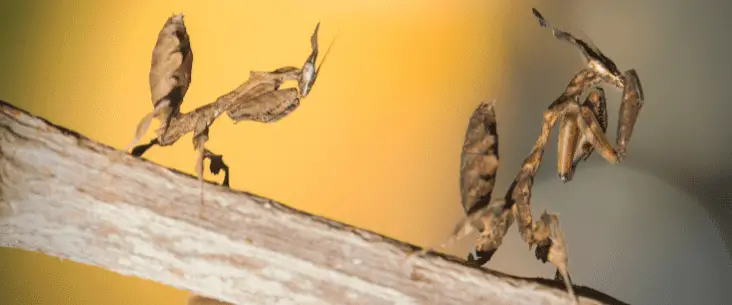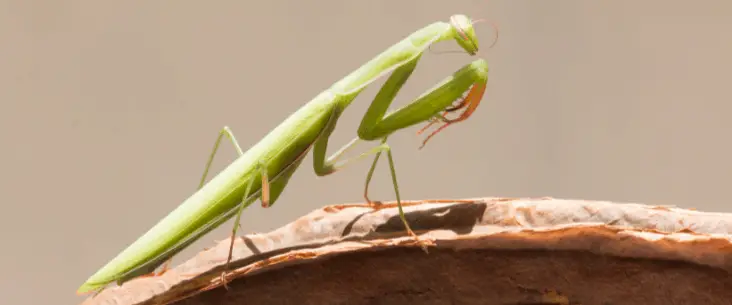Curious what a praying mantis eat? Their strangely shaped forelegs already give us a clue. But knowing what they eat, would be especially needed knowledge in the case when you consider keeping a praying mantis as a pet. What should you feed them, and how much and how often would be best for feeding a praying mantis? In this practical guide, we will discuss it all: feeding of and food for praying mantises.
Praying mantises are carnivorous hunters, and will exclusively eat on live prey. Their diet mostly exists of insects, but there are known cases of praying mantis feeding on small rodents, lizards, frogs, and even hummingbirds. An adult praying mantis eat up to 6 insects a day on average.
Don’t expect that you once in a while need to feed your pet praying mantis a hummingbird. No, there they thrive perfectly on live insects. But there is so much more to learn about feeding praying mantises, so let’s continue!
A look at the praying mantis diet
To better understand what proper food is for a praying mantis, we first need to look at what they eat in the wild. Learning from natural food sources makes the best diet for captive pets. And the food is an essential part of keeping praying mantises healthy and alive.
Wild diet
Praying mantises are carnivorous, which means they solely feed on prey items. Mantises are quite astonishing hunters that primarily feed on live insect prey. For almost any species, live insects are the main food source on which they hunt or that they ambush.
They feed on prey that they can capture, so oftentimes their prey is not larger than themselves. They hunt on vision, where some species are wait and ambush, where others will actively hunt for food.
Some species have developed opportunistic feeding methods, in which they feed on small vertebrates or hummingbirds. But they don’t catch just anything that lay in their grasps. No, praying mantises quickly learn what prey size they can successfully catch, but also learn to identify different insects. They can distinguish insects that are toxic or unpalatable.
Primary food source in captivity
For praying mantises that are kept as a pet, feeding live insects will make the primary food. Moreover, it will generally be the only food that is suitable to feed and commonly available at insect breeders and pet shops.
But there is a range of feeder insects that you can provide, so which one should you choose? There are several things you need to take into account
- All insects need to be alive when fed; otherwise, your praying mantis won’t eat them.
- The size of the insect should correspond to the body size and size of the forearms — larger praying mantises can eat larger feeder insects (dubia roaches or locusts).
- Do not feed only one species of feeder insect, but try to provide some variation. Every feeder insect has another nutritional composition, and by providing different species will keep your praying mantis healthy and without nutrient deficiencies.
- It is good practice to gut load your feeder insect before you feed them to your praying mantis. This makes the insect a more valuable food source.
- Because many praying mantises like to sit upon the higher end of your enclosure, it does not make sense to freely feed insects that only stay on the ground for those species, unless you directly feed it to them with tweezers.
- Suitable feeder insects include crickets, mealworms, superworms, dubia roaches, locusts, waxworms, hornworms, fruit flies, house flies, butterflies, beetle larvae and stick insects.
Supplemental food source
Not all feeder insects are suitable as staple food. Generally, worms typed food (mealworms, waxworms, hornworms) or beetle larvae are rather fat and low in protein. It would be best if you used them as a threat or fatten it up when you wish to breed them.
Depending on the size of mantis species, it is better to provide crickets, locusts/grasshoppers, dubia roaches and house flies (curly-winged flies). For some species, one type of feeder insect works better or is better accepted than for another species. For example, wandering violin mantises do very well on curly-winged house flies, but still accepts a waxworm or cricket once in a while.
When you provide nutritional feeder insects, you don’t need any supplemental food sources to keep your praying mantis healthy and alive.
What not to feed a praying mantis
There are some insects that are not suitable to feed to your praying mantis. Generally, praying mantis also won’t accept those. But when they do they can injure your mantis.
It is not recommended other top predator insects, like wasps, larger spiders, carnivorous locusts, (toxic) beetles, or toxic stick insects. They don’t add any advantage and only risk your praying mantis to be injured or killed.
Although some wild praying mantis occasionally eats small mice or lizards, it is not a suitable or a practical food item to feed to your praying mantis.
How to feed a praying mantis?
Feeding praying mantises is rather easy. There are actually two methods to feed them.
- Free feeding: One method is that you release the feeder insect(s) freely in the enclosure, and when a praying mantis encounters such insect can ambush or hunt it to catch the insect. This method stimulates natural hunting behaviour. However, it can take some time before your mantis have found the food or does not find it at all.
- Hand feeding: Another method is to use a tool to offer the insect to your praying mantis directly. You could use a small tweezer to grab the insect or a cocktail stick to pinch on a live insect and keep it in front of the praying mantis. This method is favoured by many keepers because your much more sure that it will find and eat its food, and you can see if it is hungry at all. However, you don’t stimulate any natural hunting behaviours.
Actually, there is no good and bad. Practically it comes down to using both methods evenly to be both sure that it eats well but otherwise also to stimulate its hunting behaviours once in a while.
How much and how often to feed your praying mantis?
Praying mantis don’t need to be fed every day. But how often and how much do they be fed then? Wild praying mantises eat around 6 insects (house flies) a day on average. But it depends on the size of the praying mantis and the size of the prey item how much you need to feed.
First, it is good practice to feed them between three times to every other day. Some regular feeding is preferred to keep them healthy. Generally, 2 live insects adjusted to the size of a praying mantis is a healthy amount of food. So, for smaller sized praying mantis would be 2 flies or smaller crickets, for larger mantises 2 locusts or smaller cockroaches will do. Females are often much larger than males and therefore need more food.
If your mantis is not accepting the food provided, then reduce the frequency you feed them. However, sometimes they refuse food items because they don’t like it, and you should first try other food items instead.
There is one exception: avoid feeding your praying mantis right before it moults. Your mantis will tell you when it is ready to moult. It will refuse food and likely scare away insects that you want to feed. If you notice that a mantis is ready to moult, remove all uneaten (life) insects from the enclosure. Insects may start feeding on the skin or knock a mantis off its perch (with deadly consequences).
It is good practice to note when and what you offered your praying mantis and if it was accepted and eaten. This way, you’ll get to understand your mantis better and will create a feeding routine much quicker. Besides a feeding log, it is good to make some notes on special events (like moults) and observed behaviour.
Can you overfeed a praying mantis?
A question often asked is if you can overfeed a praying mantis. Where other animals (like dog and cats) can eat too much, which result in obesity and unhealthy conditions. With praying mantis, however, it is next to impossible to overfeed them. They’ll eat as much as they need without getting overweight.
So you should not have any concerns about providing too much food. Too much food (when freely release them) will result in dead food items within the enclosure. Always remove uneaten prey items, preferably the same day.
How long can a praying mantis go without eating?
Generally, a praying mantis will eat every two to four days. Some will even accept food daily. But sometimes it refuses food suddenly. This is especially true when it is ready to moult, and it is normal they stop eating. After moulting, it will normally start to eat again.
There is no need for worries if your praying mantis won’t eat for a few days. A praying mantis can live for two weeks without eating any food. If it keeps refusing food for some days in a row, and there are no signs that it will moult soon, try to offer a different type of insect. Try to offer some insects that are fatter and easily digestible, like waxworms or beetle larvae.
Does the diet change throughout their lifecycle?
When praying mantis hatch, they are tiny. Many or not larger than a centimetre (0.4″). They go through multiple stages before they become adults, growing with each life stage.
Naturally, the food you provide for subadult and adult mantises is different from that what you provide to hatchlings. The size of feeder insects will change throughout their lifecycle. There are different types of food suitable for different life stages (although there are some variations between different species). The table below provides some guidance that you can provide at different life stages.
| Life stage | Average age | Suitable food items |
|---|---|---|
| Hatchlings (L1 and L2) | 0-3 weeks | Fruit flies / pinhead crickets |
| Juvenile (L3 – L4) | 3-8 weeks | House flies / small crickets / mealworms / waxworms |
| L5 up to subadult and adult | 8 and up weeks | Crickets / superworms / dubia roaches / locusts |
What is a praying mantis favourite food?
What the favourite food item is for your species depends on its own preferences. There is no one specific food item that is always liked by every praying mantis species. You’ll have to figure out yourself what the favourite item is of your mantis.
However, some food items are more favoured than others. Oftentimes the food items that contain high amounts of fat have higher preferences by mantises and can be marked as favourite food items. Examples that are generally liked more are mealworms, superworms, waxworms, hornworms and sometimes beetle larvae.
We mentioned before to log your feeding effort. If you do so, you quickly figure out what the favourite food is of your particular praying mantis. Just add variety to your diet to see what your animal likes more.
But you may wonder why you want to know the favourite food item of your praying mantis? Let me explain. When your mantis stops eating, for example, because of moulting, and it refuses food after it is done moulting. When you also tried the favourite food item(s), and it still refuses it, you know there is something maybe wrong. You could investigate if you need to adjust something like temperature or humidity or provide better perches for your mantis.
And besides that, you would like to give your mantis its favourite treat once in a while, right?

Do praying mantis need water?
Like every animal, praying mantis also needs water to keep hydrated. However, the way to provide this water differs from many other animals. Praying mantis don’t drink water from a bowl or water dish. No, they collect the necessary water partly from their food and partly from droplets on leaves, branches and the walls of the enclosure.
So, to provide water to your praying mantis, it is important to spray the enclosure with a certain regularity. It depends on the species how often you need to provide mist water. Tropical mantises can use misting almost every day, while desert type mantises collect almost all water from their food, so once every two weeks is then enough.
You have to research your species and try to find a frequency that suits them best.
Do praying mantis eat each other?
Yes, cannibalism — that’s what it is called — is rather common within praying mantises. How aggressive they cannibalise, differs between species. With some species, like ghost mantises and wandering violin mantises, cannibalism is quite low as long they are well fed. With other species, like spiny flower mantises and orchid mantises, cannibalism is more frequent.
However, there are different reasons for cannibalism. Sexual cannibalism is where the female eats the male after they mate. Adaptive foraging is the theory that cannibalism is higher when food availability is low(er).
And then there are praying mantises that seem to be genetically more aggressive towards each other, and where cannibalism happens quite frequently.
Cannibalism is common too when keeping praying mantis in captivity. Therefore the general advice is to keep mantises separated after they moult into L3. However, some mantises can be kept in (small) groups when you have an enclosure that is big enough, and you provide sufficient food. And even then, it is no guarantee that cannibalism never occurs in those species.
Want to know more?
If you like to know more about keeping praying mantis as pets, I welcome you to read our basic guide on keeping and caring for praying mantises. It is packed with practical tips and contain all information to provide the best care possible to get you started.
Share this page!



